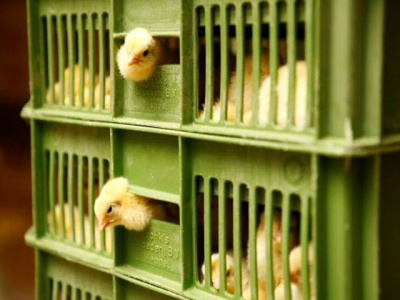Impact of dust, formaldehyde and delayed feeding after hatch

During the hatch window the early birds are exposed up to 36 hours to the hatchers environment. Depending on circumstances dust, formaldehyde and feed deprivation negatively influences the chicks start.
The hatch window of broiler chickens hatch is 24-36 hours. Most chickens are normally pulled from the hatcher simultaneously at approximately 512 h of incubation. The period that chickens stay in a hatcher varies among individual chickens. During that period, chickens are exposed to various challenges: dust, high pathogen loads, formaldehyde treatment and feed and water deprivation.
Dust
Dust originates from fluff released from the hatchlings during drying, which breaks down into fine dust. Fine dust consists of particles < 10 µm and is able to enter the body via the lungs and air sacs and settle in all parts of the body.
Heat inactivated fine dust -used to mimic effects of dust in the research- resulted in greater growth rates, suggesting that dust might have a stimulatory effect on immune responses of chickens. Dust is also an important transport mechanism for pathogenic micro-organisms, like bacteria, viruses and fungi.
After hatching, all chickens were assigned to 1 of 2 feeding treatments, early feeding or delayed feeding, and reared for a period of 7 days. Photo: Hans Prinsen
Challenges for early hatching chickens
To reduce the spread of these micro-organisms, formaldehyde is often evaporated in the hatcher.
In current practice, broilers chickens are deprived of feed and water until placement at the farm. This period of feed deprivation results in a lower body weight at placement, lower organ weights and lower post-hatch growth, especially in early hatching chickens. Early hatching chickens are withheld from feed and water and exposed to dust and formaldehyde for the longest duration before they are pulled from the hatcher. These early chickens are most affected by conditions in the hatcher compared to later hatching chickens, which condition can be worsened by applying delayed feeding.
4 experimental treatments
The effects of perinatal exposure to dust or formaldehyde, combined with the moment of first feed and water access, on development of broiler chickens at hatch and during the first week of life were studied.
4 experimental treatments (dust, form) were used from 468 until 512 h of incubation. After hatching, all chickens were assigned to 1 of 2 feeding treatments, early feeding or delayed feeding, and reared for a period of 7 days.
Body weight, and relative organ weight were measured; to measure immunological development a microbicidal capacity test and a monocyte activity test were carried out. Dust and formaldehyde during the hatching phase affect broiler chicken development at pulling from the incubator, however, no effect could be demonstrated during the 7 days rearing period.
Authors: Pieter de Gouw, Lotte LJ.F van de Ven, Sander Lourens, Bas Kemp and Henry van den Brand, Research in Veterinary Science
Có thể bạn quan tâm
 The role of enzymes and lysolecithins in eubiotic nutrition
The role of enzymes and lysolecithins in eubiotic nutrition The ban on animal proteins and consequently the sole use of vegetable proteins since the year 2000, and the complete ban on antibiotic growth promoters since
 Broiler breeders strive for balance in their lines
Broiler breeders strive for balance in their lines Continued evolution of the industry and consumer preference has and will undoubtedly continue to influence the shape of broiler breeder selection programs.
 Nuffield Scholar talks of benefits of insects for hens
Nuffield Scholar talks of benefits of insects for hens Feeding insect protein to laying hens has the potential to take off around the globe but further technical knowledge of entomology is crucial for its viability.